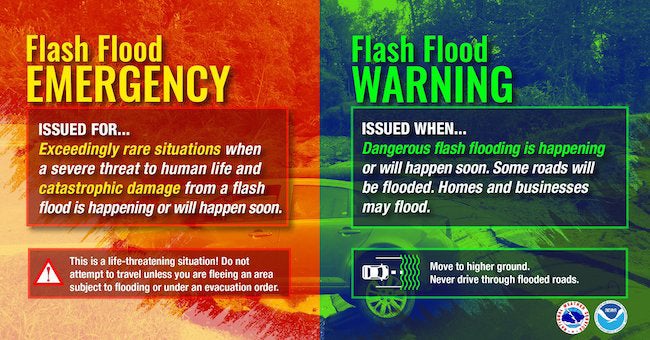Decoding the ‘Flash Flood Emergency’ Alert: A Rare and Urgent Warning That Demands Immediate Attention
When the National Weather Service issues a ‘Flash Flood Emergency’ alert, it’s not just a routine update—it’s a critical signal that imminent danger is at your doorstep. To comprehend the gravity of this alert, let’s first explore what a standard flash flood warning entails. You may have encountered these warnings, which the NWS issues when flash flooding is underway or anticipated. In 2023 alone, the NWS issued nearly 3,700 of these warnings, illustrating the prevalence of this natural hazard.
Typically, a flash flood warning indicates that streets and roads in the affected areas are prone to flooding, posing a significant risk to motorists. In some cases, even low-lying properties might be impacted, emphasizing the potential peril associated with these events. Understanding the nuances of these alerts is crucial for staying informed and taking swift, potentially life-saving actions.
Mapping the Landscape: Flash Flood Warnings Across U.S. NWS Forecast Areas in 2023
Diving into the realm of weather alerts, it’s crucial to dissect the distribution of flash flood warnings issued throughout the United States in 2023, categorizing them based on each National Weather Service (NWS) forecast area.
However, amid the substantial volume of flash flood warnings, a more serious and urgent tier of alert has emerged over the past two decades. The NWS, recognizing the need for heightened awareness in extreme scenarios, introduced the “flash flood emergency.” This rare and dire alert is reserved for moments when there is a substantial threat to life or a potential for catastrophic damage.
Notably, these flash flood emergencies are seamlessly incorporated into existing flash flood warnings, positioned prominently as a headline near the top of the warning. Understanding the distinction between these alert levels is pivotal for the public to grasp the severity of the impending weather events and take prompt actions to ensure safety.
Understanding the Gravity of “Emergency” in the Context of Flash Flood Alerts
In the context of National Weather Service (NWS) guidelines, a “flash flood emergency” is not a term used lightly. The NWS outlines specific situations that warrant such a severe alert:
- Confirmation by local or state emergency managers of rapidly rising water, placing people in life-threatening situations.
- Anticipation or occurrence of water rising to levels where typically safe locations become perilous, necessitating rescue and risking entire homes.
- Deployment of multiple swift-water rescue teams to handle an unusually severe flash flood.
- River and stream gauges indicating water levels at major or rarely seen flood levels.
- Complete failure of a large, high-hazard dam, with the potential for catastrophic impact downstream.
Comparable to tornado emergencies, flash flood emergencies are reserved for scenarios where imminent or ongoing catastrophic damage poses a severe threat to life.
document.write(‘‘);
If you find yourself in a flash flood emergency:
- Move to higher ground immediately.
- Do not travel unless escaping a flooded area or under evacuation orders from local officials.
- Avoid walking or driving through floodwaters, as their depth may be deceiving, and submerged roads may be washed out.
Notably, these highest-level alerts are rare, with only 29 flash flood emergencies issued nationwide in 2023, accounting for less than 1 percent of all NWS flash flood alerts according to the Iowa Environmental Mesonet. When triggered, these alerts are designed to cut through the noise and prompt immediate action, with smartphones emitting a distinctive loud tone as part of the wireless emergency alert system.
What are some recent flash flood emergency events? 2023 had its share of life-threatening flash floods.
In mid-March, heavy rain falling on massive southern Sierra snowpack triggered a flash flood emergency for Kernville, California, just one of several destructive flood events in the state from December 2022 through spring.
One month later, more than 20 inches of rain in less than 24 hours triggered historic flash flooding in Ft. Lauderdale, Florida.
And in mid-July, torrential rain triggered multiple flash flood emergencies in New York’s Lower Hudson Valley and parts of Vermont where roads were washed out and homes inundated.
Each of those events caused at least $1 billion damage, according to estimates from NOAA.
Other smaller-scale flash flood emergencies in 2023 included flooding in Leominster, Massachusetts, on Sept. 11, and Georgetown, South Carolina on Dec. 17. Widespread road flooding, stranded vehicles and flooded homes occurred in both cases.
